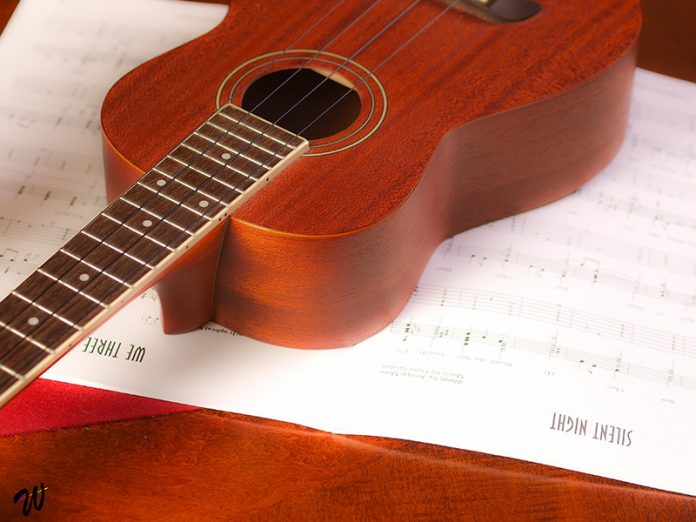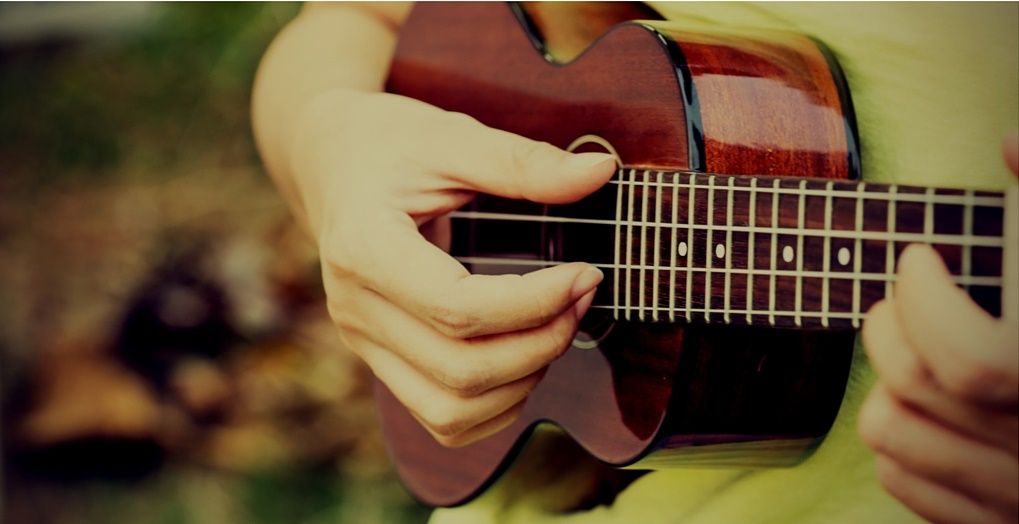We’ve made learning about the parts of a ukulele easy. Follow this easy numbered guide and know your uke like the back of your hand. Getting familiar with the parts can help when you are setting up, replacing pieces, tuning, and restringing.
Below you’ll see an image with the parts of the ukulele identified with a black arrow. We’ll cover every item 1 to 10.
[tcb-script id=”mNCC” language=”javascript”]medianet_width = “600”;medianet_height = “250”;medianet_crid = “712534424”;medianet_versionId = “3111299”;[/tcb-script][tcb-script src=”//contextual.media.net/nmedianet.js?cid=8CU7GM763″][/tcb-script]
1. What is the headstock?
The headstock is the piece farthest away from the body of the guitar. It is typically made of solid wood or plastic and has to be strong. The headstock’s responsibility is to hold the tuners and the tensions of the strings.
2. What are the tuners?
There are only four pegs on a ukulele, because there are only four strings. Each string wraps around a tuner. The tuner controls the tension and pitch of the corresponding string.
Depending on the type of ukulele you have, your tuners may stick out to the side or out the back. Some tuners are geared, which makes them easier to turn. Older versions of the ukulele rely on friction, but this is rare in modern ukes.
You can avoid breaking the strings by slightly loosening the tuners first, then tightening them. This advice is specifically important if you have metal ukulele strings.
3. What is the nut?
The nut is a small ridge that the strings rest on, in between the headstock and the neck of the ukulele. You’ll see four small notches in the nut. This is to keep each individual string in place.
Another important job of the nut is to raise the strings just a millimeter off the fretboard. This makes it possible for you to pluck your way to tune town. Just another instance where the nut saves the day!
4. What is the fretboard?
The wood directly underneath your strings is the fretboard, which is place on top of your ukulele neck. The fretboard has to be made of smooth wood, which makes it easier to attach to the neck. It’s common to see ebony or rosewood in ukuleles.
5. What are those things called frets?
The frets are located on the fretboard. They are the spaces in between the metal bars. The higher the note, the closer to the headstock.
When you run your hand down the ukulele neck towards the body and sound hole, you’ll notice that the frets get closer together. Wonder why? It’s because the closer you get to the sound hole the space and difference between a semi-tone and the next is smaller.
[tcb-script async=”” src=”//pagead2.googlesyndication.com/pagead/js/adsbygoogle.js”][/tcb-script][tcb-script][/tcb-script]
6. What is the body of a ukulele?
The body is where the sound from the vibrating strings is amplified. Ukuleles come in different body sizes and shapes. One of the most popular is the soprano ukulele.
To read more about the wide variety of ukulele shapes and sizes check out our article Types of Ukuleles. Here we go more in depth and describe all your options!
7. What is the sound hole?
On the ukulele body, just underneath the strings, you’ll see a round hole. This is where after the sound is amplified from the body of the ukulele, it exits the instrument for all of us to enjoy.
Try strumming on different parts of the ukulele, you’ll quickly find that you produce the loudest sound when you are on top of the sound hole.
Sometimes you’ll see a pattern wrapped around the sound hole; this is called a rosette. It’s purely decorative and doesn’t change your playing.
8. What are the strings?
Ukulele strings are made out of a variety of different materials. Concert and soprano ukuleles typically have nylon strings. The tenor and baritone sizes have a combination of nylon and metal-wound strings.
In number 2, we talked about how to carefully tune your uke to not break the strings, if you have a tenor or baritone and the strings contain metal, be careful here!
Fun fact: The first guitar strings were made of animal intestines.
9. What is the saddle?
Obviously, we aren’t saddling up to ride a horse or a donkey. The ukulele saddle essentially performs the same duty as the nut, it lifts the strings off the fretboard, making it possible to play. You’ll also see four evenly spaced notches to individually hold each string.
10. What is the bridge?
The bridge attaches the strings to the body of the guitar. It is glued to the body of the guitar and comes in two options- standard and tie-bar.
The standard bridge has little notches like the nut, but they are tied at the end closest to the butt, or bottom, of the ukulele. Each knot is placed in the notch. The tension keeps the string in position.
The tie-bar bridge has small holes which you can thread the ukulele strings through. The strings are then tied to the bridge to secure them to the body of the guitar.
[tcb-script async=”” src=”//pagead2.googlesyndication.com/pagead/js/adsbygoogle.js”][/tcb-script][tcb-script][/tcb-script]
What’s next?
Below we’ve included a cool video and suggested links for you to look into if you’re hungry for more. A hui kaua, until we meet again!
Peter Forrest shows some cool ukulele showboating tricks to impress your family and friends. The tricks are really awesome, his haircut is not! Fortunately, Peter isn’t giving hair styling tips and is sticking to ukuleles.






